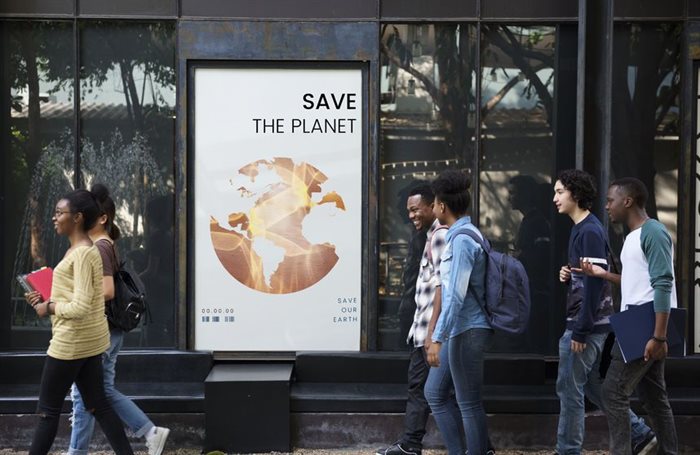Before delegates from around the world gathered in Glasgow, Scotland, in November for the 26th United Nations Climate Change conference, (COP26), the event was being referred to as 'the last best chance' for resolving climate change.
If we were to assess the Glasgow Climate Pact as a decisive turning point, then our assessment would be that of failure. However, that does not mean all is lost. Certain doors have been opened, even if we are yet to walk through them. The next COP will be held in Egypt in less than a year. This is the chance we must take. There is global momentum on climate action, even if political action is still lagging.
The reality is that expectations were already subdued, even before delegates descended on Glasgow, because on the two main issues - progress on net zero commitments to slow global temperature rise, and the finance to support low carbon development in the developing world - the cards were already dealt by the G20, and key emitters, even before any delegate badges could be collected at the Scottish Exhibition Centre venue on the banks of the River Clyde.
Besides all this, some significant milestones were reached.
The first commitment to phase down coal and other fossil fuels; the acknowledgement of loss and damage; and the creation of technical steps to address it; doubling of adaptation finance; a commitment to halt deforestation; and the finalisation of the rulebook on Article 6 facilitating carbon trading, all represent long-standing technical issues that have moved forward tentatively.
However, these technical advancements do not translate into climate action. Glasgow commitments still leave us on track for warming by 2.4°C. The latest assessment on financing showed an ongoing gap of $20bn per annum to reach the $100bn target for climate finance.
And for African countries, over 2°C of warming means a loss of GDP of around 5% per annum by 2030, according to analysis by the African Climate Policy Centre.
Glasgow reconfirmed the difficulty in making headway on finance, and the reality is that the $100bn unfulfilled promise represents only 0.4% of the total global finance mobilised to tackle the Covid-19 pandemic in less than two years.
The biggest reason for pessimism after Glasgow is that the record on implementation is low. The Paris Agreement, ultimately, is built around commitments by individual states. Commitments have not been met. Thus, even as commitments in Glasgow fall short, the question is: will even these insufficient commitments be upheld?
Pessimism is an important instrument for building realistic intervention. Therefore, despite the gaps of COP26, which are part of the struggle of multilateralism, here are five key considerations that can help us prepare for COP27 aimed at building practical climate resilience interventions for African countries:
1. With the right support Africa can deliver a green recovery
Africa’s rise and impressive growth at the turn of the century was built on the back of commodity exports and new global trading opportunities. However, this growth has not built sustainable and resilient value chains, and an urgent revamp is required for Africa to avoid a lost decade.
Analysis by the UN Economic Commission for Africa (ECA) has found a stronger correlation in jobs created and gross value addition in the economy by pursuing investment in green sectors as opposed to investment in fossil-fuel based sectors. Return on investment in case study countries showed up to 420% better returns in gross value addition and up to 250% better returns in job creation from investment in sectors such as renewable energy, climate smart agriculture and nature-based eco-tourism than in fossil fuel-based sectors.
In renewable energy, African countries are both critical as opportunities for investment in access - with 24 out of 54 countries having less than half the population reliably connected to electricity - as well as essential actors in the value chain with many of the critical minerals essential for battery technology found on the continent.
There will be no global green recovery unless Africa is part of the investment package.
Margaret Kadiri 18 Jan 2022
2. Upfront finance is key
African countries need reliable financing options to be able to invest upfront to maximise return on investment. As demonstrated in the global study from Nick Stern in 2020, the multiplier effects are higher the sooner an intervention is put into place. ECA analysis also illustrates that Africa may have lost up to five percentage points in growth due to delayed investment of stimulus in 2020.
Channelling investment into areas like renewables and transport infrastructure are further economic multipliers and can lead to a virtuous investment cycle.
African countries are overly dependent on external financing - donor driven or from foreign direct investment. The lack of development of local capital markets means that this scenario is likely to continue, although a strategic injection of seed finance in the right sectors can be transformative.
On the overall global finance goal, African negotiators called for an annual target of $700bn in Glasgow.
The African Development Bank (AfDB) estimates that African countries’ nationally determined contributions (NDCs) will represent an investment opportunity of over $3tn by 2030. It may be useful to have a goal that is specific to how much finance should be made available as grants and soft loans and more flexible targets (which should not be limited) for private finance goals.
This is particularly relevant as the conversation on on-lending of Special Drawing Rights (SDRs) gains momentum, as providing the right liquidity to Africa and the rest of the developing world will be key to Covid-19 recovery and resilience to climate change.
For Africa, being able to effectively deliver private sector climate finance will be predicated on the right upfront support - whether through blending or partial guarantees.
In any case, Africa is currently lagging in terms of access to private sector climate finance, attracting less than 3% of global private sector climate finance.
Africa and the Middle East combined also issue less than 1% of the total number of green bonds globally. Further unlocking green and blue bond markets will be an important step for Africa.
3. Africa’s energy grid is the key to unlocking growth
In terms of mitigation, Africa is already net positive, being home to 17% of the world’s population while being responsible for less than 4% of global emissions.
Based on technologies currently available, and on Africa’s demography, emissions on the continent are bound to rise. This is why the Paris Agreement recognises that developing countries will take longer to peak emissions than developed countries, who must do their fair share to mitigate climate change.
African resilience will be best achieved by adopting renewable energy pathways and developing national and regional value chains around the manufacturing and deployment of such technologies.
Crucially, Africa has been affected in recent years by fluctuating fossil fuel prices - both producing countries and net importers. Coherent long-term investment in renewables can stave off these risks and allow more predictable costs of doing business. This is critical both for the industrialisation of the continent and to further unlock the potential of micro, small and medium enterprises (MSMEs).
A just transition for Africa will also require recognition that some additional base generation will be required for rapidly upscaling investment in renewables. For example, if Africa was to double its electricity generation using only natural gas, that would allow a multiplication of solar and wind investments by 38 times, with only a 1% increase in global emissions.
The transition deal concluded by South Africa at COP26 providing financing to help transition away from coal may also provide a framework example replicable in other countries, of how to use external support to re-orientate the energy sector and avoid getting trapped in ‘stranded assets’.
4. Resilience through adaptation is critical for economic viability
Adaptation is chronically under-resourced in the fight against climate change, hence the commitment in Glasgow to double climate adaptation financing.
Upfront adaptation investment reduces long-term investment costs. As illustrated in the Global Centre for Adaptation’s 2021 State and Trends report, the cost of intervening in adaptation through agriculture is estimated at $15bn per year, which represents less than 10% of the $201bn estimated annual cost of paying for disaster relief and recovery after floods, droughts, and similar environmental disasters.
Case studies undertaken by ECA, which feature in the report, show clearly that investing in adaptation-related projects associated with critical sectors such as agriculture can bring fantastic returns on investment in terms of both value addition throughout the economy and job creation.
- In South Africa, a return of over 150% can be achieved by rehabilitation and investment in parks, while agroforestry and reforestation initiatives bring returns of over 100%.
- In the Democratic Republic of the Congo, a return of up to 450% is possible by investing in irrigation and associated adaptation measures.
- In Kenya, a return of over 200% is possible from the use of resilient seeds in agriculture and similar returns are also possible by rehabilitating and investing in natural parks.
5. Africa should be rewarded for being net positive
COP26 also concluded the negotiations for carbon trading under Article 6 of the Paris Agreement. While there are legitimate concerns raised about potential abuse, based on the lack of precision in some of the definitions, African countries have a good opportunity ahead of COP27 to leverage their considerable natural sequestration assets to be able to build resilience by protecting sensitive areas, while also raising much needed capital that can be invested in national priorities.
The peatlands of the Congo Basin alone sequester the equivalent of three years-worth of global emissions.
Meanwhile, seagrass meadows and mangroves, which feature on both Africa’s Atlantic Ocean and Indian Ocean coasts, are proven to sequester 2-3 times more carbon than tropical rain forests.
The concern is that while Africa has some of the highest remaining forest cover, it also has the fastest rate of deforestation of all continents. Thus, without care and attention, Africa’s carbon sinks can become sources of emissions.
Crucially, investing in protecting these carbon sinks can also be linked to opportunities to create sustainable livelihoods.
Ethiopia’s Green Legacy tree planting programme is an interesting example of how environmental rehabilitation, which is aimed at reducing erosion and the impact of flooding, can also be used to generate livelihoods. For instance, planting fruit trees that bring returns for communities, while addressing energy needs, thus reducing the pressure for deforestation for firewood and creating new opportunities for value addition.
Gabon is also ambitious in proposing increased value addition for its sustainable timber resources, providing protection for forests while also increasing livelihoods for communities.
Assessments done by ECA in partnership with Dalberg have demonstrated potential financial flows of $15-30bn with carbon prices aligned to the goals of the Paris Agreement.
Several African countries have also spoken after COP26 of the desire to develop an African carbon market, allowing African countries to leverage their natural capital and channel flows into adaptation and resilience.
Limitations of multilateralism
In conclusion, the response to the Covid-19 pandemic, as well as COP26, have underlined the limitations of multilateralism. We are limited by real political will, and we are condemned to move at the pace of the most recalcitrant.
In response to both Covid-19 and climate change, multilateralism has reinforced the inequalities of the international development space.
In response to the Covid-19 pandemic, G20 countries have mobilised over $11,000 per capita in response, while for low-income countries the spend per capita is on average only $57. In one African country, the spend is only $11 per capita.
The compromise of Glasgow has been to keep the doors open, and ensure that the multilateral option remains viable, even if too slow to meet the real urgency demanded by the climate crisis.
African countries should be lauded for their continued ambition, even while external financing has not been forthcoming. The African Union’s Green Recovery Action Plan is an illustration of African countries’ agency in structuring a credible response. To galvanise real action at COP27, we must aim to build up from within African countries themselves.
Article originally published on Africa Renewal.






























